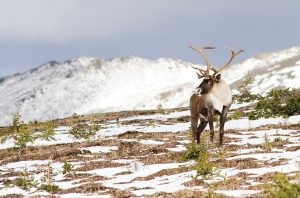
Experts and environmental groups are cautiously welcoming a proposed plan to protect seven species that have been identified as threatened or endangered under the Species At Risk Act (SARA) in Jasper National Park.
The multi-species action plan published by Parks Canada last week includes objectives and management plans for the common nighthawk, olive-sided flycatcher, Haller’s apple moss, two bats species (northern myotis and little brown myotis), the whitebark pine tree and the woodland caribou.
“I like the idea of a multi-species action plan, I think it’s a laudable effort,” said Eric Taylor, chair of the Committee on the Status of Endangered Wildlife in Canada (COSEWIC).
“Instead of doing things that are sort of piecemeal, one-by-one, I think it’s really the only way forward that collectively we can try and make some changes.”
That being said, he described a lot of the measures included in the action plan as “vague.”
Part of the problem is that for several species, such as the olive-sided flycatcher, the action plan doesn’t include concrete targets to achieve the action plan’s desired goals.
For example, on page 17 the action plan states the short-term goal is to halt the national decline of the olive-sided flycatcher by 2025, however it also states little is known about this species in the park and population monitoring will be done through “incidental observations.”
“An incidental effort isn’t really going to do much,” said Taylor, who is also a professor with the department of zoology at the University of British Columbia.
“It’s not that they want to avoid doing the real work it’s that they realize, I suppose, that they have limited resources and they have to be able to make some sort of statement while not over committing because they don’t know what their budget is going to be next year.”
He blamed the lack of monitoring and targeted measures on cutbacks to Parks Canada’s scientific capacity.
“The root cause is limited resources. We’re just not spending enough money on this,” said Taylor.
He was also highly critical of the contradiction between reducing the threat to existing caribou populations outlined in the plan and a proposed plan by Parks Canada to build a 109-km paved bike trail through critical caribou habitat.
“It’s ludicrous to put development through critical habitat. It completely degrades the entire idea of why we define critical habitat and why it is important,” said Taylor.
“To create these action plans costs money and to identify critical habitat costs money and if they’re not going to use that information because they’re going to put a bike path through it or they’re going to say it’s not as critical, that just seems crazy to me.”
According to Parks Canada, the proposed Icefields Trail project would make use of an already disturbed corridor along the existing highway and is currently in the conceptual phase. No final decisions have been made.
"The detailed impact analysis for the Icefields Trail concept would thoroughly consider impacts to critical habitat and include any mitigations required to be fulfilled by Parks Canada to offset any impacts on caribou habitat," wrote Steve Young, a communications officer for Parks Canada.
Canadian Parks and Wilderness Society (CPAWS) said it too had concerns about the multi-species action plan.
“We’re certainly very supportive of them taking action on species at risk since they do have a legal responsibility to do so,” said Kecia Kerr, executive director for the northern chapter of CPAWS.
“A major focus in the report seems to be the requirement under SARA to identify and protect critical habitat, but we are concerned about the fact that we continue to see proposals that destroy critical habitat such as the bike path.”
In terms of actual measures to implement the action plan, she said there seems to be very little proactive planning aside from a plan to plant 3,500 rust resistant whitebark pine seedlings by 2019.
“It just seems to be indicative of their reduced capacity for conducting scientific monitoring and doing active conservation,” said Kerr. “They mention things like they would like to augment caribou population size, but the plan to augment that was cancelled a few years ago.
“It just seems like actions speak louder than words.”
According to Young, Parks Canada is currently working with partners to determine the feasibility of both breeding caribou and reintroducing animals to reduce the trend of declining populations, but given the uncertainty of it a thorough assessment is required.
On top of that he said Parks Canada would need to find a partner with the necessary expertise and resources to contribute to any breeding program that might be initiated.
A draft version of the multi-species action plan is open to the public for comment until July 28. To review the plan and provide input visit: www.sararegistry.gc.ca.
Paul Clarke
[email protected]
